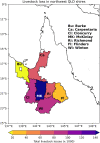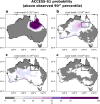Multi-week prediction of livestock chill conditions associated with the northwest Queensland floods of February 2019
- PMID: 35396558
- PMCID: PMC8993847
- DOI: 10.1038/s41598-022-09666-z
Multi-week prediction of livestock chill conditions associated with the northwest Queensland floods of February 2019
Abstract
The compound extreme weather event that impacted northern Queensland in February 2019 featured record-breaking rainfall, persistent high wind gusts and relatively cold day-time temperatures. This caused livestock losses numbering around 500,000 in the northwest Queensland Gulf region. In this study, we examine the livestock chill conditions associated with this week-long compound weather event and its potential for prediction from eleven world-leading sub-seasonal to seasonal (S2S) forecast systems. The livestock chill index combines daily rainfall, wind and surface temperature data. Averaged over the event week, the potential heat loss of livestock was in the moderate to high category, with severe conditions on the day of peak rainfall (5 February). Using calibrated forecasts from the Bureau of Meteorology's S2S forecast system, ACCESS-S1, a 1-week lead prediction showed a 20-30% probability of extreme livestock chill conditions over the northwest Queensland Gulf region, however the highest probabilities were located to the west of where the greatest livestock impacts were observed. Of the remaining ten S2S systems, around half predicted a more than 20% chance of extreme conditions, more than twice the climatological probability. It appears that the prediction accuracy arose from the skilful forecasts of extreme rainfall, as opposed to cold day-time temperature and strong wind forecasts. Despite a clear association between the observed extreme weather conditions and an active Madden-Julian Oscillation (MJO) event stalling in the western Pacific, the majority of 1-week lead S2S forecasts showed little indication of a slow-down in the MJO. As the livestock chill index was developed for southern Australian sheep, it may not be the best metric to represent the effects of exposure on tropical cattle breeds. Hence, this study draws attention to the need for tailored diagnostics that better represent the cold effects of summer tropical cyclones and tropical depressions on northern Australian livestock.
© 2022. The Author(s).
Conflict of interest statement
The authors declare no competing interests.
Figures







References
-
- Cowan T, et al. Forecasting the extreme rainfall, low temperatures, and strong winds associated with the northern Queensland floods of February 2019. Weather Clim. Extrem. 2019;26:100232. doi: 10.1016/j.wace.2019.100232. - DOI
-
- Hall, T. J. Pasture recovery, land condition and some other observations after the monsoon flooding, chill event in north-west Queensland in Jan–Mar 2019. (2020).
-
- Gissing A, O’Brien J, Hussein S, Evans J, Mortlock T. Townsville 2019 flood: Insights from the field. Risk Front. Brief. Note. 2019;389:1–8.
-
- Deloitte. The social and economic cost of the North and Far North Queensland Monsoon Trough. (2019).
-
- Wellington, M. Development of indicative Temperature Humidity Index charts for northern Australia. (Meat & Livestock Australia Limited, 2019). 10.13140/RG.2.2.27406.59201
Publication types
MeSH terms
LinkOut - more resources
Full Text Sources
Research Materials

